The Differences Between Woven & Non-Woven Geotextiles
Geotextiles are designed to improve soil stability in your landscaping project. These man-made materials are typically are made from polyester or polypropylene. In this post, we will discuss the various differences between woven and non-woven geotextiles. But first, woven geotextiles offer 5 different purposes for high performance.
• For Separation • For Reinforcement • For Filtration • For Drainage • For Erosion Control
Woven Geotextiles:
Woven Geotextiles are made by weaving narrow strips of film together in order to provide reinforcement and separation. These geotextiles are often specified by tensile strength and are resistant to deformation when under pressure. Woven fabrics are somewhat plastic-like in appearance and in touch. They are mostly impenetrable and typically do not provide adequate drainage. Woven geotextiles do have the capacity for very high loads and are normally used under roads and parking lots.
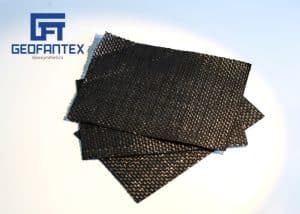
Woven Geotextile Attributes:
• Separation • Reinforcement • High Tensile Strength • Low Water Flow Rate • Plastic-like To The Touch
Non-Woven Geotextiles:
Typically used for separation, filtration, and drainage, these fabrics are created using needle punching vs weaving. Non-woven are referred to by weight and appear and feel like felt in texture. They are penetrable and are normally used for drainage and filtration applications.
Non-Woven Geotextile Uses:
• Separation • Filtration • Drainage • Referenced By Ounce Per Square Yard Weight • Penetrable • Felt-Like To The Touch
Using the correct geotextile in your landscaping project will increase its lifespan and improve your overall design. You will be less likely to end up with callbacks due to drainage issues or settling if you apply the correct product for the project.
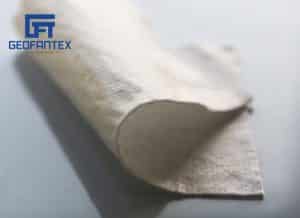
Non-Woven Fabrics in French Drains:
Non-woven fabrics are often used in french drain applications. If you are not familiar with french drains, you probably don’t know when they are the best choice or how to install them. If you have a neighbor whose land sets up higher than yours, you will probably have excessive water or moisture on your property. Water could easily run down from their property and land in your yard. Therefore, you are going to need a really good drainage system for your yard and the installation of french drains is an excellent option.
In some cases, people will call a drainage system as a French drain that is a drain pipe and then filled with gravel. That said, the French drain is basically filled with gravel but there is no pipe involved. The term “gravel” can vary from one place to another. In this article, gravel is an aggregate of small stones.
Installation Of A French Drain:
First, find the area on your property where excessive water is accumulating from the slope and be rerouted. Your options will be determined by where the water is being rerouted to. Obviously, if water is flowing toward your home’s foundation and this water will harm your foundation, then you need to find a place to move this water to quickly. The perfect french drain location should be an out-of-the-way area that has sandy soil where water can travel harmlessly.
Keep in mind that the area you choose to reroute the water should not impact someone else’s property. If your french drain does divert water to someone else’s property you could be looking at a lawsuit so be careful! Also, you need to check your city codes before attempting to dig and check with your utilities to know where your underground cables are located because you can’t dig there. Locate your local Dig Safe phone number to make sure you will be excavating in a safe place.
Ideally, you want to run your french drain along the slope on your side of the property line. You want an area that does not have obstacles or obstructions. Before starting to dig, you should layout your french drain area. You will have to create a small slope in order to carry the water to its final destination. A grade of 1%, which is a drop of one foot per every 100 feet in length, is highly recommended. Some will advise a drop of 6-inches for every 100 feet.
It is essential to get the water to flow where you want it to in order to improve your yard’s drainage and therefore the grade will help in your efforts.
How To Measure The Grade:
Place two stakes into the ground that will mark the beginning and the end of the trench. Tightly tie a string to one of the stakes and then run it to the other stake and tie if off but loosely. Attach a string level to the string and adjust the string to get it level. Once it is, tighten the string on the second stake. You want to ensure the string is taut. Now you can start digging your trench. While digging, you will be able to measure down from the string to ensure that you are getting the desired grade.
Check your depth as you go along. If your trench is at the proper length, 100 feet and grade 1%, once you have reached 50 feet, your trench should be 6-inches deeper than from where you started.
The hardest part of the french drain is the digging which is a horizontal trench that goes across the length of the slope. Your trench must slope down to the area where you will have the water rerouted and if it doesn’t make it to the chosen spot, you will have to dig a connection ditch which will be added work.
The width of your trench will depend on the level of water issues you have. Obviously, the more water, the wider the trench will have to be. Smaller trenches are normally around 5 to 6-inches.
Before you place your gravel fill, make sure your trench lines up with the fabric. Your non-woven fabric will prevent dirt from getting into the gravel. Your gravel needs to be protected so it can permeate the water through it. This is critical in order for the french drain to operate properly. Place coarse gravel onto the fabric then fold the ends of the fabric over the gravel.
Once done, you will have a tube of fabric filled with gravel. To fill in the rest of the trench, place a layer of coarse sand and then cover that with landscaping fabric. Then add 4-inches of topsoil and place sod on top of it. Your drain will be completed.
Tips For Helping Beginners:
If you are having difficulty getting the proper grading, it’s highly advisable that you consult with a contractor or someone who knows how to carry out the entire project. Also, if the idea of digging the trench is hard to do, hire a backhoe operator. This will add to your costs along with the cost for added gravel because a backhoe cannot dig a small trench like one can do manually. Another alternative is renting out a trencher which can cut very thin trenches.
Keep in mind, if you can use a small trench for your drain, you will save quite a bit of money and will require a lot less gravel. The most difficult process involved in a french drain is figuring out where to run the water. If possible, the best avenue is to run the water out to the road where the city’s drain system will deal with it. That said, you would have to research to find out if this a good avenue or not.
The Items You Will Need For Your Trench Construction:
• A spade or shovel • Drainage fabric • Gravel • Sand • Sod • String level string • Two stakes • A tape measure
Another alternative might be a dry creek bed for placing your drain to solve your problem.
Landscape Fabric 201: The Difference Between Woven and Nonwoven Fabric
Having a beautiful, well-maintained property is every landscaper’s dream. Weeds and lack of drainage are two common lawn stressors that can be managed with the help of landscape fabric, but which task requires woven, and which requires nonwoven landscaping fabric?
Woven and nonwoven landscaping fabric have different strengths and weaknesses.
● Woven landscaping fabric is strong, durable, and useful for weed control and supporting walkways and driveways.
● Nonwoven fabric is slightly weaker but allows water drainage at the cost of less effective weed control.
While these are the only two main types of landscape fabric, each type offers multiple uses. From keeping soil in place and to protecting landscapes from intermittent weather, they each provide benefits for keeping your landscape looking good as new! We’ll discuss them more in detail below, as well as how to choose the right fabric and install it properly.
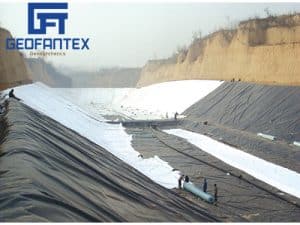
Does it Matter What Kind of Landscape Fabric to use Between Woven and Nonwoven types?
Whether you’re an avid landscaper or an admirer of your neighbor’s lush green lawn, chances are you’re familiar with landscape fabric. Even if landscaping isn’t your niche, there’s a good chance that you’ve seen landscape fabric before.
In addition to being used on residential lawns, it is also used in places like:
● Playgrounds
● Commercial landscapes and properties
● Really, anywhere else there’s landscaping and property management happening!
Landscaping fabric is all around you. Still, knowing what it is and knowing how and when to use the different types that exist are two very different things. In order to properly understand how to use landscape fabric properly, you need to understand what the types are and in what situations they should be used.
For example, one of the most common issues when it comes to all things lawn and garden related is weeds. Those pesky shards of grass that creep through the cracks of your driveway and take over your garden beds can be disruptive. To add to this issue, treating weeds can be a tricky task, even with the right herbicides.
Choosing the wrong type of fabric to install could mean the difference between proper weed control and barely any at all! The two main types of landscape fabric, woven and nonwoven, each provide their own benefits when being used on certain types of landscape.
What Are the Differences Between Woven and Nonwoven Fabric?
Woven and nonwoven landscape fabrics differ in their materials, uses, benefits, and disadvantages. The type of fabric you use will depend on a number of factors, including:
● Where you plan to install it
● The type of earth you are placing it on top of
● Your climate
● The purpose of the installation
One of the main differences between woven and nonwoven fabric is the type of material each one is made out of. Woven fabric is made out of polypropylene material. This material is woven together, creating a crisscross pattern that is extremely strong and durable. Woven landscape fabrics are great for heavy duty projects.
Nonwoven landscape fabric is made from polypropylene that has been bonded together rather than woven together like the alternative fabric. Once bonded together by using thermal heat, holes are needle punched through the material, making it permeable. This makes nonwoven landscape fabric easier to cut and permeable.
Regardless of the type of landscape fabric you use, each one has multiple uses in terms of what it can provide for your landscape.
Woven Fabric
Woven landscape fabric consists of polypropylene that has been woven together, creating a strong impenetrable layer of fabric. This unique pattern makes the material strong in terms of holding its shape and providing a solid membrane.
Photo Right:
Woven landscape fabric is typically used for roads and paths because of its strength
Woven landscape fabric is best suited for:
● Use on the blacktop, under patios, and garden beds. Woven fabric is extremely durable and best suited for landscapes that require stability. For situations in which a paving material is being laid down, a woven fabric can prevent the pavement from sinking into the soil.
● Jobs that require strength and durability. As mentioned before, woven landscape fabric is less likely to wear down over time compared to nonwoven fabric. Its strong material makes it an ideal fit for providing stability to certain landscapes.
● Landscapers on a budget. Woven fabric is slightly cheaper in comparison to nonwoven fabrics. In addition, its longer durability over time means that you won’t have to replace it as often. This will save you money over time!
The thick material of woven fabric makes it the ideal choice for heavy duty placements such as on roads, blacktops, and paths. In addition to these benefits, woven fabric tends to last longer compared to nonwoven fabric. Its particular design makes it UV resistant to an extent, allowing it to last over time.
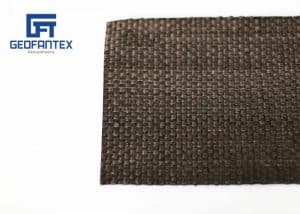
Nonwoven Fabric
Nonwoven landscape fabric offers a lot more benefits compared to woven fabric. For starters, nonwoven fabric offers a moderate amount of durability. Although, it isn’t as strong as woven landscape fabric, its manufacturing process increases its water permeability. This benefit is crucial to proper drainage and preventing waterlogging from happening.
Photo Right:
A nonwoven fabric is the appropriate type of fabric for any French Drain Application
Nonwoven landscape fabric is best suitable for:
● Supporting proper soil drainage. Having proper drainage is extremely important when it comes to landscaping. This ensures that the soil and receives adequate moisture without the area becoming waterlogged.
● Uses beneath patios, driveways, and roads. Similar to woven fabric, nonwoven can also be a great choice for various heavy duty uses. Though lighter and thinner, nonwoven fabric is still able to retain much of its durability.
● Walkways constructed of stone or gravel. With gravel or stone landscape, there has to be a way in which water can drain and filtrate through either of the materials without causing any flooding. With this benefit, proper drainage is maintained, and the landscape materials do not sink into the soil.
● Blocking weeds from growing uncontrollably. One of the biggest uses of all landscape fabric is for weed control. By preventing sunlight from reaching the weeds, nonwoven fabric helps with controlling them.
Nonwoven landscape fabric is made of a lighter material, making it the ideal go-to for landscape matters involving flower beds and gravel landscapes.
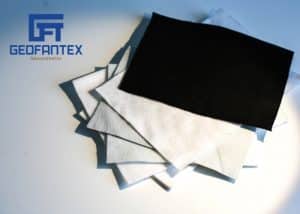
What Are The Five Uses of Landscape Fabric?
There are many uses for landscape fabric; several of them have been previously identified. There are however five specific uses of landscape fabric.
These five uses of landscape fabric are:
● Separation
● Stabilization
● Reinforcement
● Filtration
● Drainage
These are all important factors to consider when it comes to landscaping. Placing landscaping fabric down does not serve just one single purpose, it can serve many all at the same time.
Before you can decide which landscape fabric to use, you need to first understand the basics of the five different uses.
Knowing that, you can then assess your plan, choose which of the 5 uses are a higher priority and make an informed decision about which fabric to use.
Separation
Believe it or not, there are so many aspects that go into landscaping. From knowing which plants work where to knowing how to properly place landscaping fabric, there is so much to know. When it comes to the relationships between dirt, soil, gravel, and such, these can easily be overlooked.
If you’re not familiar with some of these concepts, it would be easy to assume that all types of soil were created equally. Likewise, it’s also easy to assume that all soils mesh well together. Both assumptions are wrong. In fact, not all soil types mix together equally.
Because certain types of soil have different consistencies compared to others, the mixing of such soils can cause inconsistencies when it comes to the very ground that you walk on. When incompatible soil types mix together, it causes the ground to become uneven as a result. In cases such as these, landscape fabric is necessary.
Landscape fabric helps to keep soils with different inconsistencies separate by acting as a barrier between them. This prevents them from mixing and causing the ground to sink.

Stabilization
Stabilization is another benefit to using landscape fabric. Ground stabilization and soil separation go hand in hand in many ways. On one hand, landscape fabric keeps soils of different inconsistencies separate and on the other hand, it also helps to stabilize them.
Stabilization is a big part of landscaping. For instances in which there are slopes involved, landscaping fabric is an absolute necessity. Because erosion is more likely to occur, having fabric there to stabilize the slope is crucially important. Not only does it keep the layers of soil separate, but it also keeps them stabilized.
Woven fabric is best suited for stabilization, as it is more durable and there are even brands specifically designed for this use. It is also often used for heavy duty placement, such as:
● Under patios
● Driveways
● Roads
Not only does it keep the soil in place, it also keeps the material on top from moving around.
Reinforcement
Among the other four uses of landscape fabric, reinforcement is by far one of the most important. In some way, shape, or form, reinforcement is involved in all aspects of landscaping and fabric makes it possible.
In cases where the landscaping has been damaged, the soil had been depleted of nutrients, and similar scenarios, using fabric as a reinforcer allows the area to recover. When placed on areas that need a little landscaping TLC, landscape fabric can prevent them from exposure to the sun and from being invaded with weeds.
Likewise, it you find that your garden beds have become completely depleted and deprived, using fabric can give the soil time to recover and build up its nutrient levels once again.
Filtration
Filtration is an important aspect to maintaining a suitable landscape, as it allows for soil particles to filter through without becoming clogged. Nonwoven landscape fabrics are great for uses relating to filtration and drainage. Nonwoven fabrics are permeable, meaning that water is able to pass through them.
By using a permeable landscape fabric, you can ensure that water and soil will be able to properly drain and filtrate.
Drainage
Admit it, no one loves a swampy lawn, parking lot, or garden bed. A swampy disaster such as these often results from poor drainage, resulting is waterlogging. On flatter terrains, the chances of the landscape becoming waterlogged becomes higher, as the soil provides little to no drainage.
Drainage is highly important in maintaining any form of plant system, whether it is grass, a garden, or flower bed. Likewise, drainage is also important when it comes to blacktop areas, beneath patios, and areas with gravel.
If you use woven fabric in a place where you need a lot of drainage, you can run into many issues down the line.
Improper drainage can lead to:
● Erosion of soil
● Instability of the driveway or other structure on top
● Overwatering of plants (and subsequent death or illness)
● Gross, smelly “bog” conditions of the soil
Finding the Right Landscape Fabric
As mentioned before, the two main types of landscape fabric are woven and nonwoven. Although these are to only two main types, these fabrics come in a variety of brands and styles. Even more important, they come with their own price tag as well!
When finding the right landscape fabric, some things you should look for and consider are:
● The cost
● The quality of the fabric materials
● The fabric material itself
What to Look For in a Good Fabric
There are many qualities to good landscape fabric. These qualities can include those mentioned above as well as which job the fabric is best suited for. Because different landscaping fabrics are best suited for different jobs, it’s important to specifically what to look for in each kind of fabric.
Overall, it takes looking a bit of research to know what to look for a good landscape fabric for your specific needs. While any fabric will provide some good benefits, finding a well-reviewed, well-made fabric to do the job will ensure you don’t run into any unforeseen consequences down the line.
How to Use Landscape Fabric
Knowing how to properly use landscape fabric is as equally important as knowing why you should use it. When properly placed, landscape fabric can provide a number of benefits, but fabric that is misplaced or better yet not performing its job at all can be problematic.
For this reason, knowing how to use landscape fabric comes with its advantages.
As mentioned before, no landscape fabric is fully weed-proof. There is no guarantee that placing down landscape fabric is going to eliminate the presence of all weeds but doing so will at least prevent the majority of weeds. This is an important point to keep in mind, as many people assume it will get rid of all weeds.
Although it is not 100% weed-proof, the proper usage of landscape fabric can provide control and maintenance when it comes to other things. For example, in areas where there’s a slope present, using landscape fabric can help control the rate of erosion. Likewise, it can also prevent landslides from occurring.

The Benefits of Using Nonwoven Landscape Fabric
Using fabric in your next landscaping project can have some major benefits here are a few of the most common ones.
While landscaping fabric adds an extra expense and more work, this shouldn’t deter you from using it to maintain your landscaping project. After all, using landscape fabric does come with its fair share of benefits!
As mentioned before, some of the benefits to using landscape fabric include:
● It helps the soil to retain moisture
● Better weed control
● Helps to maintain the overall state of the targeted terrain/landscape
● Eliminates the use of harsh chemicals to control weeds
● Acts as a stabilizer and reduces erosion
Although it is not completely useful in fully eliminating weeds, it does do a satisfactory job overall. Likewise, you will not need to use a harmful weed control alternative in its place. There is a major difference between dealing with a handful of weeds and a yard full of weeds.
How to Install Nonwoven Landscape Fabric
Once you’re fully aware of how to use landscape fabric, you can move on to actually installing it. This task doesn’t require too much higher thinking aside from measuring and a bit of planning. In order to ensure that the fabric will do its intended job, it has to be properly installed. A proper installation guarantees all benefits to using the fabric.
Depending on the purpose the fabric will serve, the installation process may differ. For instance, if you plan to use it for ground stabilization and soil separation, there may be more steps involved in the installation process. The next steps on proper installation provided below will give you a basic overview, regardless of the purpose.
Before you begin the installation process, make sure that you have all of the basic materials gathered. For basic proper installation you will need:
● A measuring tape
● The landscape fabric of your choice
● Pins, ground staples, or stakes to keep it in place
● Whatever you plan to cover it with (gravel, mulch, or soil are common choices)
Measure the Area
Using a piece of measuring tape, measure the area you wish to place the landscaping fabric on. This will give you a proper estimate of how much landscaping fabric you will need for the job. Likewise, it will also give you an idea of how much covering, gravel, pins, and other materials you will need.
Cut and Place the Fabric
Once you’ve gotten a proper measurement, you can begin placing the fabric over the designated area. Be sure not to cut the fabric based on your measurements before you place it!
Image Right: Cutting landscape fabric is easy with a pair of scissors or a razor knife
Before placing the fabric down, remember that the fuzzy side of it goes face down. This feature will better allow it to be secured to the soil beneath it. This is especially beneficial if it is being placed on a slope.
It’s recommended that you place the fabric over the area first and then cut it. If needed, you can cut sections of fabric once you’ve placed it. If you need sections to cover the area, allow about 6 inches for the edges of each section to overlap. Once you do so, allow about 2 inches of excess fabric to remain.
You will cover this with soil later on in the installation.
Secure the Fabric
After placing and cutting the fabric, secure it in place by placing pins around the areas that come into contact with the soil. You can do so by placing a pin every couple of feet.
Designate Plant Areas
If you plan of planting plants within the designated areas, be sure to mark where the plant will be. You can do this by marking the space with an “X” and folding back the excess fabric to reoccupy the open space for the plant.
By doing so, you create a space for the plant, but protect it from the mulch or other landscaping materials that you will use to cover the fabric.
Repeat the same process for all spots where you plan to install deep-rooted plants, like trees.
For this part of the installation, it’s important not to leave too little or too much open space for the plant. If you know what type of plant you will place there, make an exact measurement of the space before cutting back the fabric. Too much open space surrounding the plant is just asking for weeds to make an appearance.
Place Landscaping Materials
Last but certainly not least, place the landscaping material of choice onto the landscaping fabric. Whether it’s mulch, gravel, rocks, etc., the same process applies. The final layer of all materials should be about 2 to 3 inches thick.
Landscaping Fabric: Woven VS Nonwoven
Remember the two key differences between the fabrics:
● Woven fabric is strong, durable, and ideal for path and road construction, weed control and stabilization—but it doesn’t allow for as much drainage.
● Nonwoven fabric is still fairly strong, but also allows the drainage of water. Its ideal for filtration and drainage applications. However, it is not as effective at weed control.
Sources
Landscaping Fabrics Buyer’s Guide
Urban Turnip
4 Factors Help You Choose the Right Landscaping Fabric
How to Use Landscape Fabric for the Right Jobs
Pros and Cons of Using Landscape Fabric
3 Uses for Landscape Fabric
North Coast Gardening
All You Need to Know About Landscape Fabric
